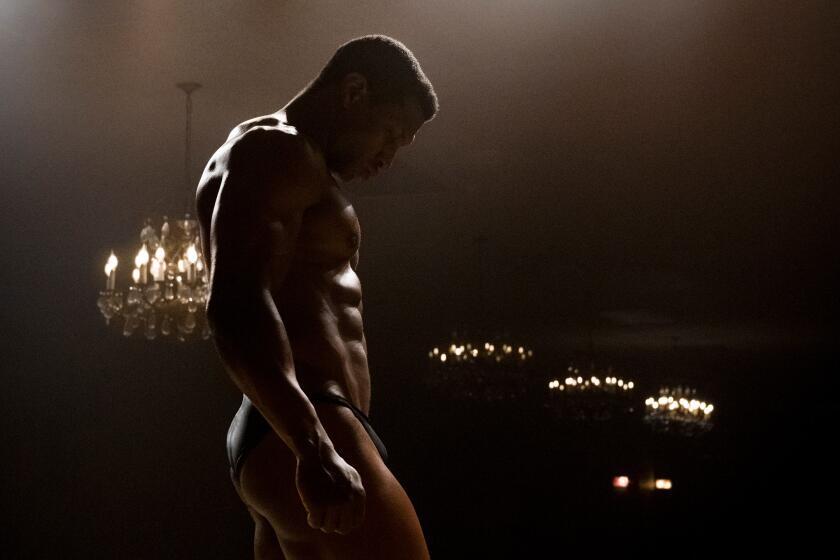Kindness is the takeaway in the Holocaust-era-set ‘White Bird: A Wonder Story’

- Share via
In 2017, the film “Wonder” was a surprise critical and commercial hit for Lionsgate. Adapted from a children’s novel by R.J. Palacio, the film starred Jacob Tremblay as young Auggie, a boy with the facial deformities of Treacher Collins syndrome who teaches his family and peers about the importance of kindness. (Julia Roberts and Owen Wilson co-starred as his parents.) Naturally, a sequel, adapted from one of Palacio’s “Wonder” spinoff books, was quickly green-lighted by the studio.
It’s now been seven years since “Wonder” came out, and the long-awaited sequel, “White Bird: A Wonder Story,” which has been plagued by delays both pandemic- and strike-related, is finally hitting theaters. Directed by Marc Forster and written by Mark Bomback, “White Bird” is very loosely connected to the original film, but it takes a more global, historical approach to the same message about the importance of small but high-stakes gestures of kindness.
Bryce Gheisar returns as Julian, Auggie’s bully from “Wonder,” who has been expelled from school for his cruelty. Now himself the new kid at a new school, he struggles to fit in. But Julian has the opportunity to reinvent himself, which is underscored by a surprise visit — and lesson — from his grandmother Sara (Helen Mirren) that completely changes his perspective on how to move through the world.
Thus unfolds the real story of “White Bird,” which isn’t about Julian, who serves merely as a framing device and a tenuous link to the world of “Wonder.” “White Bird” is actually Sara’s story of her childhood in Nazi-occupied France and the harrowing events she experienced as a young Jewish girl there.
We’ve mapped out 27 of the best movie theaters in L.A., from the TCL Chinese and the New Beverly to the Alamo Drafthouse and which AMC reigns in Burbank.
If you’ve ever watched (or read) young-adult Holocaust films or fiction, “White Bird” will feel familiar. It takes a similar tack to real-life stories such as Anne Frank’s. Teen Sara (Ariella Glaser) is the adored and privileged daughter of a professor and a doctor (Ishai Golan) living an idyllic life in a small French village. Drawn to the handsome Vincent (Jem Matthews), she and her friends scoff at quiet Julien (Orlando Schwerdt), who is disabled from polio. Insulated from the harsh realities of occupation until laws limiting the freedom of Jews encroach on her town, Sara’s family makes plans to escape, though they are unable to outrun the Nazi roundups.
Sara, though, manages to escape into the snowy woods, and Julien escorts her through the underground sewers away from the school to his family’s barn where he stows her away, and where he and his parents (Gillian Anderson and Jo Stone-Fewings) care for her. She will remain there, in hiding, until the forces of fascism that have infected her community must be reckoned with. But the story is about the connection she forges with Julien, and the circumstances that allow her to learn to evaluate character through shared humanity and bravery, not status and power.
The strength of “White Bird” lies in its performers, especially Glaser and Schwerdt, who deliver complex, nuanced takes on young people experiencing global atrocities on an intimate scale, while also trying to navigate the complications of connecting as teenagers. They are both excellent and keep the film emotionally grounded.
Forster presents a somewhat sanitized view of the Holocaust that is sobering but digestible for younger audiences. The pastoral setting remains picturesque and almost fairy-tale-like. As recounted through Sara’s memories, it has a kind of glowing haze about it, almost too beautiful at times. Computer-generated flowers bloom before our eyes. A cranberry-red coat stands out starkly against a snowy winter background. It’s an interesting stylistic choice (and one you may have seen in another much-celebrated Holocaust movie), but it speaks to the storytelling element of the film, the way our brains craft memories that might be more vivid and lovely, even after decades.
As a “Wonder Story” and a Holocaust story, the messaging of “White Bird” is unsurprising though important: Empathy matters, especially in action, and that often, caring for others can mean putting one’s own self in danger, but we should do it anyway. In the grand tapestry of human existence, we are all connected. It may be a message we’ve heard time and again, but it’s one that bears repeating.
Katie Walsh is a Tribune News Service film critic.
'White Bird: A Wonder Story'
Rating: PG-13, for some strong violence, thematic material and language
Running time: 2 hours
Playing: In wide release Friday, Oct. 4
More to Read
Only good movies
Get the Indie Focus newsletter, Mark Olsen's weekly guide to the world of cinema.
You may occasionally receive promotional content from the Los Angeles Times.










